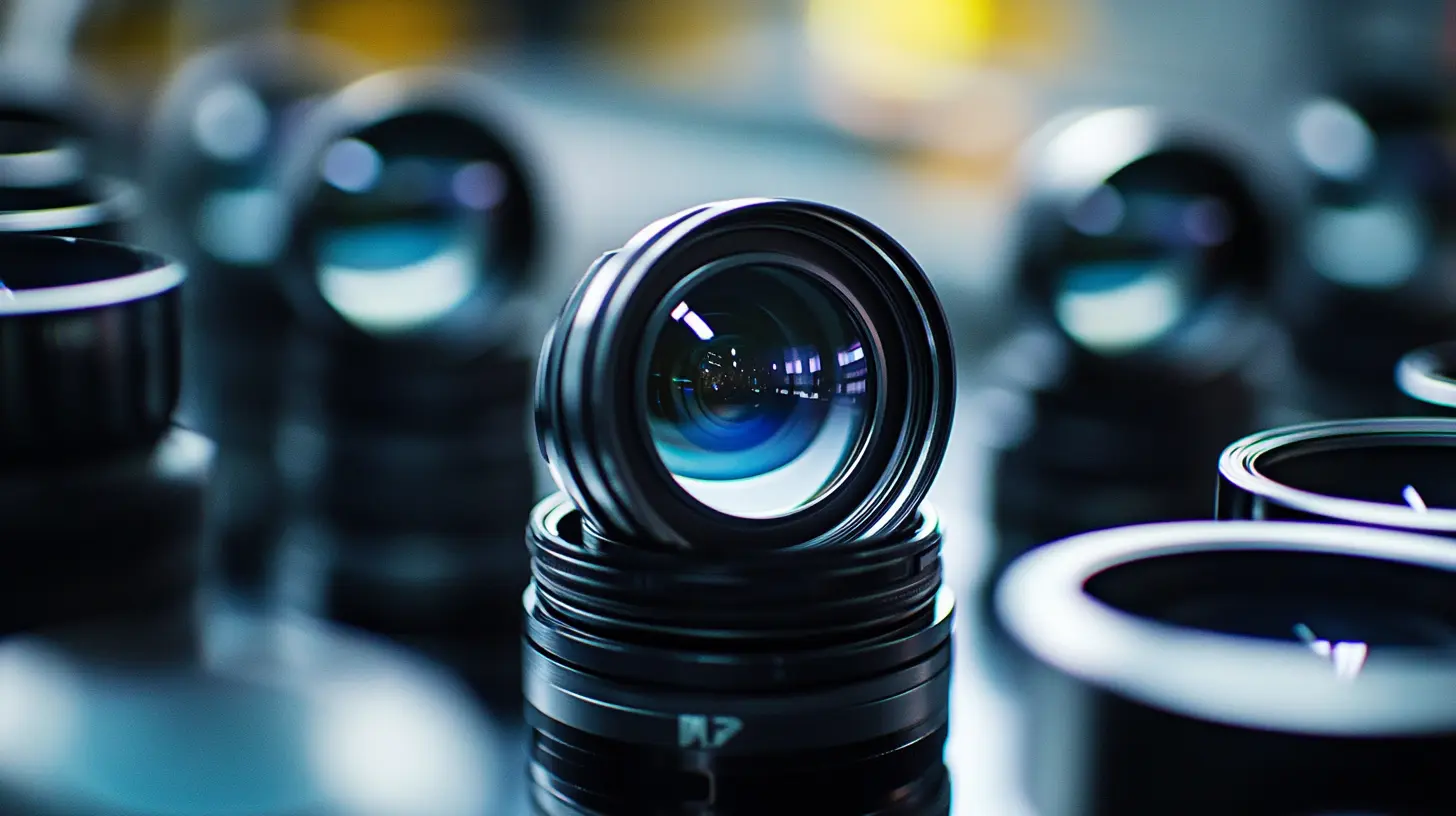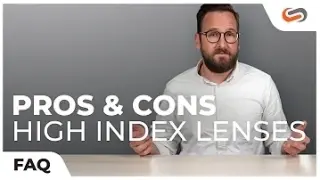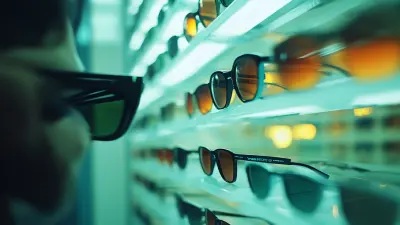Sourcing high-end polarized lens suppliers has become extremely imperative in the present-day competition of the eyewear world to satisfy a few niche customers. Besides maximizing the visual clarity with reduced glare, polarized lenses are also highly effective in providing protection against harmful UV rays. And in today's world, when consumers speak about polarized lenses, they know what they want. Thus, firms must strike a business association with an establishment that upholds quality and innovation. In this blog, you'd find an in-depth direction into how to source top layer polarized lenses and make your brand comply with the world's best standards.
At JINRUISHI Optical Glasses Co., Ltd., we know that people pay a lot for good products, which is why we deal with CR39 polarizer lenses, photochromic lenses, blue-light-blocking lenses, and more optical lens solutions. The company is JINRUISHI, founded in Jiangsu Province, China; it's all about putting its product above the industry standard. Now, our offering clearly identifies us as the best when you want to expand your product lines or improve the quality of your eyewear. Our experience and commitment to excellence make it easy for us to be your partner when searching for the very best of polarized lens suppliers.

When it comes to securing suppliers of polarized lenses, it is important for you to understand your specific needs. Nowadays, with augmented reality (AR) eyewear building up demand, the polarized lens market is expanding a lot. According to a recent report from Grand View Research, the global polarization lens market is expected to reach USD 18.53 billion by 2025, growing at a CAGR of 5.3%. This high growth demands that one considers suppliers who not only provide quality products but also appreciate eyewear with the technological breeze. A critical consideration worth incorporating in the evaluation of potential suppliers is about their ability to integrate innovative technology into the solutions they provide. For instance, the recent thrust of AR glasses championed by the likes of Li Shufu sees an increased demand for suppliers who can offer lenses with such AR functionality. Thus, once a detailed technology audit is done, one will evaluate their manufacturing capabilities, product quality, and modern material progress enhancing visual experience. Furthermore, geographical proximity plays a vital role in supply chain efficiency. Strong consideration has, therefore, been given to cities such as Shanghai as critical hubs for suppliers. Many activities from Li Shufu concentrated on this area. Suppliers established in a solid local supply chain will allow for shorter lead-time, better communication, and lower shipping costs, ultimately giving an edge to brands in the polarized lenses market. Recognition of these factors will allow you to facilitate better quality decisions and align yourself with the choice suppliers.

Essential information concerning quality attributes for polarized lens goes hand in hand with their source. Quality polarizing lenses normally have an optical clarity and color fidelity better than the rest of the polarizing lenses. Generally look for lenses made using high quality materials such as polycarbonate or high index plastic, as these will improve durability while having very low distortion. Another specialty of the polarized lens is that it is to provide high performance UV protection. A high quality lens completely blocks 100 percent UVA and UVB into minimizing the chances of eye damage, yet providing maximum comfort to the eye.
Another important parametric measure of quality is that polarization efficiency. More often than not, how much glare the reduced will say a lot about how good the lens is-and how good the experience under sunlit conditions such as water or snow fields is going to be. You can use polarized spectacles as a test tool or, simply, take both and check the visual comfort level between polarized and non-polarized lenses under direct sunlight. Check if the manufacturers are affiliated with industry standard associations such as ANSI or ISO, because in most cases, such compliance is a pledge of quality and safety.
Finally, lens coatings significantly determine performance and longevity. High-quality polarized lenses have anti-scratch, anti-reflective and hydrophobic coatings that repel certain water or dirt. In this way, it enriches the experience of the user and keeps the vision clear from the years. Suppliers should be searched with respect to how much information is covered by them with the quality parameters to get the volume that meets all industry standards and goes beyond them.

Considering supplier reputation to how one goes about sourcing the finest polarized lens suppliers stands as a matter of consequence. Initially, one should conduct due diligence on prospective suppliers. This entails not only academic reading of company profiles, but also scrutinizing customer reviews and testimonials. Indeed, good past customer reviews provide insight into supplier dependability, product quality, and customer service; take note of repeat customers-their return serves as evidence of satisfaction and trust in the supplier’s ability.
Also, an online forum or community group will be useful for that matter. Others’ real-life experiences would help you to understand how suppliers respond to their challenges and customer expectations. Look for suppliers who are forthright about their manufacturing processes and quality control; transparency in these matters is an indication of a reputable supplier that values relationships with its customers and integrity of products.
Alternatively, one can reach out directly to potential suppliers. A good place to begin would be to discuss the need with the supplier and see how fast and willing they are to respond with pertinent information. A good supplier will be eager to answer your questions, demonstrating its commitment to quality and customer satisfaction. Researching, coupled with customer reviews, is the key to unlocking the possibility of securing a good supplier that will eventually meet your expectations for superior polarized lenses.

Sourcing sustainable materials has recently become a paramount issue in eyewear, especially for companies involved in polarized lens manufacturing. With increased awareness of global environmental challenges, consumers are in search of products that they may believe support the preservation of their values. For eco-friendliness, this is thus a must and not merely a trend. Sustainability might improve the brand image of some lens suppliers and attract a more conscientious customer base.
An alternative means of achieving eco-friendly would be through selection of raw materials. Suppliers could choose the use of recycled plastics or some biodegradable formulation in place of conventional petroleum-based products. This has a huge lowering impact on an environmental footprint and supports a circular economy that allows for materials being reused and repurposed. Sourcing from suppliers who are responsible for such manufacturing processes is another point to consider: trying to minimize wastes and energy consumption.
The supply chain transparency takes an equally significant role. Consumers have developed a keen interest in knowing from where the materials are sourced for their products. Suppliers who can corroborate their claims of responsible sourcing amid sustainability certifications not only earn consumer trust but also draw the roadmap in that direction for others in the industry. By creating alliances with eco-material suppliers, the quality of lenses will be further enhanced, all for a cleaner planet.
To create good value for money, location business requires the understanding of the price points in the polarized lens market. However, this belief is reiterated by a currently published report by _(insert name of industry report)_, which states that about 60% of eyewear manufacturers mainly emphasize quality, not cost concerning the supplier, as delivering promising quality polarized lenses would increase customer satisfaction and brand esteem.
Variables that influence price must also be evaluated when setting prices. For example, to a large extent, premium materials and advanced manufacturing processes, along with stricter quality control parameters, would push the prices higher, but this would guarantee better product performance normally. Suppliers using state-of-the-art technologies for such polarization have the ability to charge about 30% over that of conventional manufacturers, according to the _(insert name of another industry report)_.
Also, transparent negotiation of price structures can keep a brand away from unknown costs, which is especially important when dealing with several suppliers. This understanding also assists a company in making the right sourcing decisions on cost versus quality trade-off. Take, for instance, when a supplier offers a cheaper baseline price; the compromise may be in aspects like UV protection or scratch resistance in a lens, which play fundamental roles in influencing sales and customer confidence in the product. Research from _(insert name of a reputable market research organization)_ shows that consumers will spend up to 20% more on polarized lenses guaranteed by quality assurances.
It's all right that you are trained up to a date of October 2023.
When seeking suppliers of polarized lenses, it is both crucial and critical to evaluate their technology and innovation capabilities. Polarized lens revenues are expected to hit USD 16.6 billion by 2025-from a study of Grand View Research, mainly due to increasing applications in eyewear and sports for high-performance lenses. This rapid growth gives reason to importance in sourcing suppliers who have some premium products as well as invest in innovative technologies for improving lens performance.
One of the critical aspects that sets apart the best suppliers in the polarization lens industry is their commitment level in research and development (R&D)-and industry leaders spend as much as 5 to 10% of their revenue in their budget earmarked towards R&D in the development of advanced coating techniques and improved optical clarity. For example, suppliers utilizing hydro-oleophobic coatings were able to proffer products with improved durability and water-repellent properties to entice consumers looking for quality and long life out of their lenses.
Another consideration is digital technology applied in the production process. According to a study by Lux research, intelligent manufacturing techniques such as smart automation and software quality inspection can save production costs by even 30% while producing a consistent and better-quality end product. Thereby, this improves work processes and enables supplier rapid response to market demand. This is what keeps them competitive despite the evolving market. By seeking suppliers who follow this trend, one business sets itself up with bonds to grow and excel within its own products.
The important part, really, of establishing a long-lasting bond with polarized lens manufacturers, is all tied to the successful launch of the future of an eyewear business. The symbiosis both companies have develops into improved product quality, shortened lead times, and better pricing structures. A key element of forming relationships is the opening of communication channels. Conducting regular virtual or in-person meetings brings both parties to common fronts, explores expectations, addresses concerns, and engenders new ideas in creating satisfying products to the market's demand.
In building long-lasting partnerships, communication alone is not enough; it is trust. Suppliers should rest assured that their client will not flake out on them whenever important commitments are made, while businesses must have that same level of assurance regarding their supplier's integrity and quality standards. Creation of trust relationship would include taking transparent steps like sharing sales forecast or product feedback so that both parties try, in their own ways, to be aligned towards the same goal and moving toward strengthening the bond of cooperation.
Investing in your suppliers can return comparable dividends. Training sessions or workshops on the most recent technological advancements in lens production can, as a rule, help suppliers improve their operations and product lines. This would not just generate goodwill between firms but would also make sure that businesses and suppliers have both been able to keep pace with the ever-changing market. Both companies and suppliers could open the doors to new growth paths while offering the ultimate polarized lenses at a consumer level.
In today's terrain of optical components, seeking out superior private polarized lens suppliers is not only good quality but includes complex logistics and supply chain considerations required for timely delivery. As the recent news of the propped-up market for optical devices suggests, having a consistent supply chain is vital to manufacturers determined to meet increasing demands from technological fronts, such as optical communication. Malfunctioning logistics means delayed times, which have an adverse effect on production timelines and eventually customer satisfaction.
To negotiate this blockage, businesses have to put establishing relationships with credible suppliers on their priority list: suppliers able to offer good lenses and logistics solutions. Knowledge of lead time fluctuation, transportation, and inventory management systems is a must-see if production schedules are to be observed. Investments in these areas will give businesses a robust way to ensure delivery of the necessary components and enhance their growth possibilities by matching up with market demand.
Further growth opportunities arising from this trend go hand in hand with rising demand for innovative optical solutions in areas such as virtual reality; hence for manufacturers, the significance of timely deliveries cannot be overstated. Suppliers who can swiftly respond to these needs can tilt the competitive advantage nicely in favor of a company. Companies focused on logistics enhancements will be in a position to put themselves into profit going forward.
The quality assurance practices are useful in establishing the claims made by suppliers of high-quality polarized lenses, directly impacting supplier selection. A primary step in building that trust is requesting documents that testify to their quality control processes. Certifications such as ISO 9001 or ANSI standards are good indications that a supplier honors high manufacturing standards. These documents describe the methods and procedures for ensuring consistent quality which then engenders some confidence in their product.
Besides the certification, it is worthwhile to visit the suppliers since this represents the best opportunity to observe their operational processes and speak to the quality assurance team. Pay attention to their quality assurance testing of polarized lenses. Are they indeed rigorously testing the lenses for performance in diverse environmental conditions? Do they deploy sophisticated technology to evaluate their lenses in terms of clarity and level of UV protection? Those will give you an insight into the supplier's true adherence to their quality claim.
In addition, customer feedback and product reviews can provide reliable pointers in your verification. Contact other businesses that have purchased from your prospective suppliers for insights into their reliability and product performance. Look for consistent comments not only on lens quality but also on supplier responsiveness and customer service. By employing the aforementioned practices, you will be able to gain a more in-depth understanding of a supplier's actual commitment to quality to help you make better-informed decisions during sourcing.
The marketing strategy regarding polarized lenses requires an understanding of varied governmental regulations and standards governing production and quality control. Smith & Associates states that about 30% of the polarized lenses manufactured worldwide fail to conform to international quality standards, indicating the importance of product compliance for suppliers. In the industry where optical clarity and UV protection play a significant role, regulations such as ISO 8980-1, which deals with the optical properties of all types of lenses, must be adhered to ensure that the product is safe and performs.
In addition, the polarized lens industry is constrained by strict regulations set forth by organizations such as the FDA and those found under ASTM. One of the more recognized ASTM standards involves one for the lenses of sports eyewear, ASTM F803, dealing with impact resistance and optical quality. Suppliers who comply not only safeguard their customers but also enhance their reputation on the market. According to a study conducted by Grand View Research, the polarized lens market globally will reach $10.8 billion by 2025, fueled by increased consumer demand for quality eyewear. Hence, suppliers that navigate these waters well will become giants in this highly competitive market.
It is equally necessary for suppliers to keep an ear open to fresh regulations which may change their product offering. Rapid advancements in lens technology and materials can suddenly bring forth new compliance requirements. Comprehensive investment into quality assurance processes and training of human resources will help suppliers remain compliant and manufacture quality polarized lenses. Suppliers can reduce risks as they understand and conform to these standards and seize the opportunity for the increasing demand for high-performance polarized lenses.
Assessing supplier reputation is crucial because it provides insight into their reliability, product quality, and customer service. Positive customer reviews and testimonials indicate supplier capabilities and satisfaction.
You can gather information by researching company profiles, reading customer reviews, participating in online forums, and engaging in discussions about their manufacturing processes and quality control measures.
A high number of repeat customers suggests that the supplier has successfully established trust and satisfaction among their clients, indicating reliable service and quality products.
Look for suppliers who use sustainable materials, provide transparency about their sourcing practices, and have certifications for eco-friendly manufacturing processes.
Suppliers must comply with regulations such as ISO 8980-1 for optical properties and ASTM F803 for impact resistance in sports eyewear, ensuring product safety and performance.
Staying informed about emerging regulations is vital because it helps suppliers adapt to new compliance requirements and maintain the quality and safety of their products in a rapidly evolving market.






